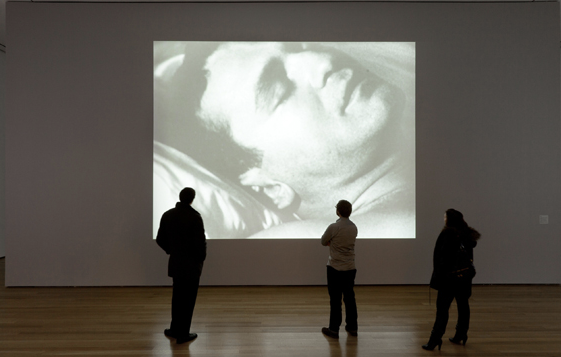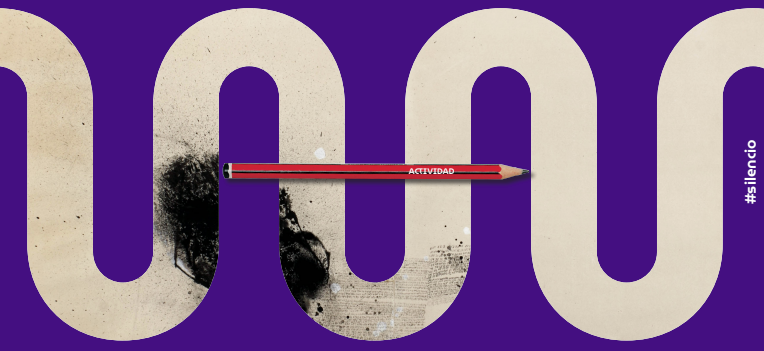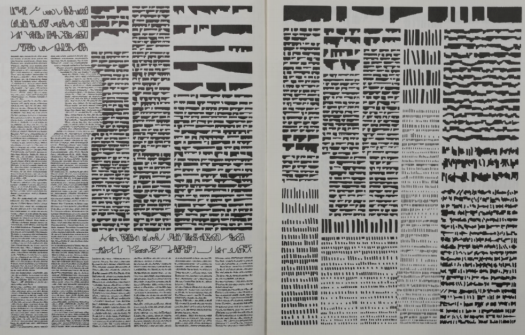Three great friends talk about silence in music, quantum physics and literature, and about its role in art, meditation and the unsayable in the poetic process. They also discuss that silent hiatus, that rediscovering of suspended silence prompted in its recipients by the contemplation of art.
Even in the most absolute silence we still hear our hearts beating, our breathing, the faint rustle of leaves. But how does that silence play out in the streets of our towns and cities in these strange days we are living through?
Today more than ever a space is needed to make silence possible. Small wonder then that in answer to the Moderno’s call so many Argentinian and world artists did not think twice about taking up the gauntlet of silence as a desirable area of research that, over the years, has drawn or tested them. In such a context we are pleased to introduce a series of works and thoughts by such renowned and diverse artists and thinkers as Diana Aisenberg, Pedro Aznar, Martín Bauer, Luis Conde, Fabiana Galante, Mariano Gil, Alberto Goldenstein, Juliana Iriart, Cesar Lerner, Alberto Rojo, Aldo Sessa, Alejandro Tantanian from Argentina, Lenora de Barros from Brasil and Bernardo Ortiz from Colombia. Welcome to the meaning-packed world of the significant pause and the listening ear.
After pianist David Tudor took to the stage on 29 August 1952 for the premiere of John Cage’s piece 4′ 33” in front of a blank score, nothing in twentieth-century would ever be the same again. Everything could be heard in those notorious minutes, and that roaring silence at the piano became a legend, provoking discomfort, laughter and ferocious criticism. Cage’s gesture redefined the concept of music and contemporary art forever: art went on to incorporate real life and with it, chance, spontaneity, soundscapes or non-musical phenomena as valid compositional tools. By 1951, inside Harvard University’s anechoic chamber, Cage had experienced how the murmurings of our own bodies block the sensory experience of the void. Borges too had denied the existence of silence, calling it a ‘myth of the language or full unconsciousness or protracted metaphor. We all talk about silence but barely conceive of what it is, and the murmur of the blood in our ears belies it in our solitude.’
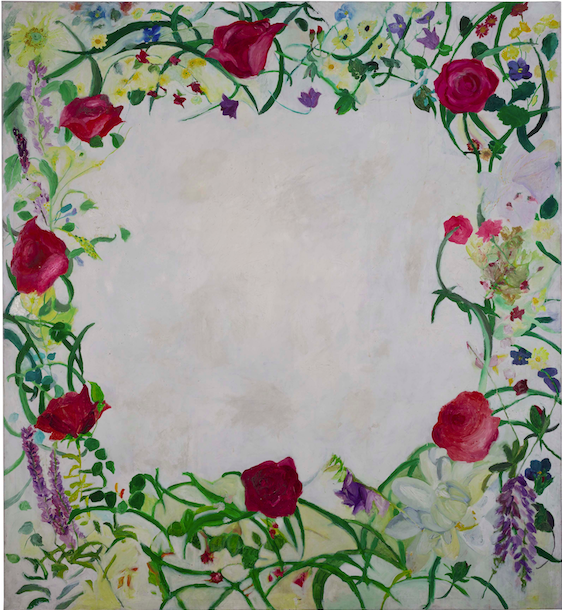
Diana Aisenberg, Marco (1995)
óleo sobre tela, 180 x 180 cm, Colección Banco Supervielle, Buenos Aires
Crédito fotográfico: Viviana Gil
The trigger for 4’33” appears to have been the series of white paintings by Cage’s friend Robert Rauschenberg. In the artist’s empty canvases – that space with no apparent intervention – could still be seen shadows and lights, and the dust in the air. Something of ‘real’ life, unmediated and signless, permeated that ‘degree zero’ of expression, that unsaying. The primal gesture was to become meaningful.
What does silence tell us today?
Gabriela Comte, editor-in-chief at Museo Moderno
Disabled Theater (2012/2014) Concept : Jérôme Bel A film by Aldo Lee y Jérôme Bel By and with: Remo Beuggert, Gianni Blumer, Damian Bright, Matthias Brücker, Matthias Grandjean, Julia Häusermann, Sara Hess, Miranda Hossle, Peter Keller, Lorraine Meier, Tiziana Pagliaro
Coproduction : Theater HORA and R.B. Jérôme Bel Duration : 1 h 37 Lenguaje : alemán con traducción al inglés Recorded in Schauspielhaus Zürich (Switzerland), March 2014
Asistance and translation: Simone Truong Dramaturgy: Marcel Bugiel Producing manager: Ketty Ghnassia Artistic director Theater HORA: Michael Elber General manager Theater HORA: Giancarlo Marinucci
Production credits of the original piece Disabled Theater (2012) Production: Theater HORA – Stiftung Züriwerk (Zurich) Coproduction: Theater HORA, R.B. Jérôme Bel, Festival AUAWIRLEBEN (Bern), Kunstenfestivaldesarts (Brussels), dOCUMENTA (13), Festival d’Avignon, Ruhrtriennale, Festival d’Automne à Paris, Les Spectacles vivants – Centre Pompidou (Paris), La Bâtie – Festival de Genève, Hebbel am Ufer (Berlin) With the support of: Stadt Zürich Kultur, Kanton Zürich Fachstelle Kultur, Pro Helvetia, Stiftung Denk an Mich, Ernst Göhner Stiftung
Acknowledgments: Sasa Asentic, Tom Stromberg, Andreas Meder (Internationales Theaterfestival OKKUPATION!), Stiftung Züriwerk, Fabriktheater Rote Fabrik Zürich and the audience of our public try outs
R.B Jérôme Bel is supported by the Direction régionale des affaires culturelles d’Ile-de-France, French Ministry for Culture and Communication
In 2013 Disabled Theater (2012) was selected for the Theatertreffen de Berlín and won the Swiss Dance Awards – Current Dance Works
The great French choreographer, Jérôme Bel, has generously contributed the filmed version of his acclaimed play Disabled Theater (2014) for the week on #Silencio, part of our #MuseoModernoEnCasa programme. Bel has been interested in what happens beyond the performative since the beginning of his career. In Disabled Theater he collaborated with a group of professional actors and actresses with cognitive disabilities from the Zurich-based company, Theater Hora. The play openly discusses the process of meeting between themselves and their director. Their experiment to foreground disability for their audience builds up a reflection about what society defines as normal and puts what is generally silenced by cultural bias right on stage in front of them. Bel elects to put difference centre-stage as a key to read what it is that enables us to think in a common dimension.
‘One of the challenges for me is to make the community these actors represent more visible, to show that these unvalued actors can still enrich experimental theatre, that their uniqueness is full of promise for theatre and dance, just as their humanity should be for society at large.’
Jérôme Bel.
www.jeromebel.fr
uliana has created four special programmes for our fortnight on the theme of silence at the Moderno. In this present, which gathers us before our screens, her work lets us pause our eyes for a while and enter the texture of words, their tones and silences, their rhythms and emotional qualities, and to accompany us as we give our own images shape and colour. In Radio de cuadros the voice is a vehicle bearing images through the air to materialise in those who hear them. Juliana Iriart dons her radio voice through ‘The Lying Poet’, a pseudonym that allows her a distance and freedom from herself, but which also relates ‘lying’ with subjectivity, since it isn’t ultimately the painting itself that ends up on the radio, but a collaborative poem built up between the painter, the poet and the listener/imaginer. The paintings she tells are by artists who are no longer alive, but who lived in Argentina and were little exhibited in their day.
Radio de cuadros has existed since 2019 and can be listened to at https://soundcloud.com/la-poeta-mentirosa
Bernardo Ortiz
Sin título
4′ 33″
(2018-2020)
Animación y música digital
An 8-bit cloud creeps slowly across the screen. Nothing else happens. Just the cloud. A guitar plots the volume of transactions on the Dow Jones over 2020, while an oscilloscope plots the Dow’s daily closes for the same period. Nothing else happens.
Bernardo Ortiz (Bogotá, 1972) is an artist and writer. He has a BA in Fine Arts from the Universidad de Los Andes (Bogotá, Colombia) and an MA in Philosophy from the Universidad del Valle (Cali, Colombia). His recent exhibitions include: Baja resolución [Low Res] (Casas Riegner, Bogotá), Fricción [Friction] (Luísa Strina, São Paulo, Brazil), Borrar [Delete] (Museo de Arte Moderno de Buenos Aires, Argentina). He has also taken part in collective exhibitions like the 30th Bienal de São Paulo (São Paulo, Brazil), the 11th Lyon Biennale (Lyon, France) and the 20th Biennale of Sydney (Sydney, Australia). His work features in major collections like Tate Modern (London), MoMA (New York, USA) and the Centre national des arts plastiques (Paris, France).
César Lerner
Corazón [Heart]
Video
2’, 31”
César Lerner (composition, piano, gong and electronics)
Violeta García (cellos 1 and 2)
Dylan Lerner (mixing and mastering)
César Lerner, Sesenta [Sixty]
Video
3´, 27”
César Lerner (composition, piano and electronics)
Elías Gurevich (violin)
Dylan Lerner (mixing and mastering)
César Lerner on quarantine: ‘Quarantine – this cul-de-sac still without an end – has been the frame for the rethinking and completion of my latest studio work, Sesenta [Sixty]. These quarantine videos carry extracts of this music. They’re play, minimal expressions of something maximal that so far isn’t thinking of surrendering.’
César Lerner, Corazón (2) [Heart (2)]
Video
1’, 59”
César Lerner (composition, piano and electronics)
Violeta García (cellos 1 and 2)
Dylan Lerner (mixing and mastering)
César Lerner, Si yo fuera
Video
1′ 18″
César Lerner (composición, piano, bodhram y electrónica)
Elías Gurevich (violín)
Dylan Lerner (mezcla y mastering)
Claudia Chueke (imagen)
César Lerner is an Argentinian composer, pianist, accordion player and percussionist. Internationally renowned, Lerner has undertaken numerous projects recreating klezmer music with Marcelo Moguilevsky, as leader of his own quartet or with violinist Elías Gurevich. He has composed the music to some of the most successful films in Argentina, including Fabián Bielinsky’s Nueve reinas [Nine Queens] and Daniel Burman’s El abrazo partido [Lost Embrace] and Derecho de familia [Family Law]. Together with Claudia Chueke in 2019 he created the performance which he personally embodies: Experiencia Acordeón [Accordion Experience] which premiered at the Kirchner Cultural Centre (CCK). For over twenty years he has been coordinating his ‘Drum Circle’, a platform for inclusion through music in areas of social care, corporations, art and education. Among other distinctions Lerner has been awarded the 2000 Silver Condor Prize for best film music on Esperando al Mesías [Waiting for the Messiah], with the 2001 Silver Pentagram Prize at the Mar del Plata International Film Festival for El abrazo partido [Lost Embrace] and the 2008 Fourteenth Madrid International Short Film Festival Prize for the soundtrack to Javier Mrad’s Teclópolis [Techkeyville]. He recently won the Award of Excellence at the Hollywood International Independent Documentary Awards (HIIDA) for the soundtrack to Poli Martínez’s documentary Lea y mira [Read and Look].
This book is a document of Alberto Goldenstein’ first retrospective, The Matter Between the Edges. Photographs 1982–2018, presented at the Museo de Arte Moderno de Buenos Aires in 2018. Through a comprehensive set of images and texts by curator Carla Barbero and Lucrecia Palacios it explores crucial aspects in the work of a key artist of Argentinian photography. It also contains a chronology of his life and work by Belén Coluccio.
Alberto Goldenstein finds a major ally in these extraordinary times to work his latest photographs, taken with the camera on his mobile phone. The artist develops a central gesture in his work: the idea of a total visual field, breaking with the concept of the single photo. As in all his series one image answers another, together tracing a keen and elegant conversation.
This book is a document of the work conducted by the Museo de Arte Moderno for the exhibition, Aldo Sessa Archive 1958–2018: Sixty Years of Images. Intense exploration of the photographer’s archive made possible an unexpected journey along the endless pathways of his oeuvre, and his many interests and investigations, to reveal a gaze built up from a tireless desire to go beyond, using the technical possibilities of the different cameras of the day. Alongside the visual journey provided by this exhaustive research, there is an interview, in which the artist discusses his technical and aesthetic ideas, and a complete biography.
Fabiana Galante and Luís Conde
Pieza con piano [Piece with Piano]
April 2020
Editing: Carlos Murat
The artists Fabiana Galante and Luís Conde – hands and gramophone – share a sonovisual action in context. As a pianist, teacher and sound artist Fabiana Galante ranges across a broad spectrum. She works in the field of current music on a case-by-case basis as a performer, improviser and builder of sounds interlaced with texts, images, performances or other sounds. She uses both new and ‘retro’ technologies and collaborates with musicians, composers and artists from other disciplines at home and abroad. Luís Conde is a restless musician who leans towards the contemporary. A performer and university lecturer, he plays saxophone, clarinet, shakuhachi flute, bagpipes and didgeridoo, often electronically or unconventionally treated.
Mariano Gil
Bass flute, video and animation
Zeke Zima
Guitar and mixing
silence
inside and out
vacuity
not the vacuum of black holes
but
spontaneous appearances
yes, and with no voices commenting
analysing, judging, naming
light in shapes
dream with nobody dreaming
path with no print
like a bird in flight
essence of the elements
beyond concepts
you enlightened guide
that speaks
without speaking
silence
Estudo para facadas [Study for Stabbings]
2012
Video
1’, 32”
Photography and camera: Ruy Teixeira
Editing: Felipe Pereira Barros
Audio editing: Dan Zimmerman
‘The work is divided into parts or “chapters”. In the first a filmed close-up of the artist’s mouth reveals her slowly mouthing a scream without words. Fade out. The second “chapter” is a still image of her tongue being stabbed, with the sound of the act overdubbed. Another abrupt cut. The next “chapter” is a repetition of the first act with a higher-pitched sound. A last break before the final “chapter”, in which the still displays the first slash and pronounces silence with a second stab of the knife. Lenora confronts the different media (television, cinema, photography) that invade and shape the gaze, daily life and behaviour of people, and which invest in models and strategies of narcotising seduction and thinly veiled violence. They are totalitarian (political, cultural, religious, whatever) discourses that promote blinding and silencing strategies, manipulating desire and violating our ability to judge. Overall, the work is by no means rhetorical or complaining but, by showing the birth and death of images allegorically, Lenora urges us to question the nature of our relationship with images and our image-mediated relationship with the world. The very status of the image is also at stake: it is elevated above and goes beyond the visible realm, which it exalts and torments in turn, but from which it is formed. This unease is contained in the representation of death, its enigma and the character-cum-artist’s suspended scream.’
Excerpt from Facadas [Stabbings] by Felipe Scovino, for the catalogue of the Third Show in the 2012 Exhibition Programme, São Paulo Cultural Centre.
Alvos[Targets]
2017
Video
6’, 28”
Production and editing: Marcia Beatriz Granero
Production assistant: Luiza Calmon.
Post-production: Yuri Amaral, Fabio Bardella
Design and sound mixing: Gustavo Vasconcelos
‘During the research process for my production of Alvos I found some copies of targets used in gun clubs. I was shocked by the violence these “decomposing” figures were charged with after receiving the gunshots: images of bodies that never lived, yet died violent deaths. The targets used in shooting academies are a discomforting, disturbing presence at a time when violence is spreading frighteningly, turning against specific targets, but more randomly too. The Alvos video was recorded in the range of a shooting academy in São Paulo in September 2017. At one point in the shoot I put the target over my own face, like a mask. What captured my attention about the image of the target was that the point the shooter had to aim at was right over my mouth. I find that symbolic connection with tongue and language fascinating: language and communication under attack, and the threat of prohibition, communication in crisis and symbolic violence.’ Lenora de Barros
Lenora de Barros is a Brazilian artist and poet. She studied linguistics at the University of São Paulo before establishing herself as an artist in the 1970s and has remained committed to exploring language through a variety of media, including video, performance, photography and installation. Barros began her career producing visual poetry. Her early works were influenced by concrete poetry, particularly the Noigandres Group, incorporating body art, pop art and conceptual art techniques. Her work has evolved to focus on the sonority of words, particularly through sound installations and voice performances.
The Escuchar [Sonidos visuales] [Listen [Visual Sounds]] cycle curated by Jorge Haro and Leandro Frías has put together this playlist around the notion of silence from a sonic arts perspective. An exploration of sonovisual contrasts. So often separated and classified as opposites, sound and silence are but two aspects of the physical world of vibrations. Discreet or conspicuous. The experience opens with a nineteenth-century space where sounds can ‘just be’, moves on to the
overcrowding of circuitry and sound density of a boiler room inhabited by a ‘noisy’, continues with the deep listening proposed by the frozen image of a CD cover and thence to words about the world of vibrations, to close in the stillness of a study caressed by the wind. Silence in words and sounds.
This week’s playlist brings you 90 minutes of listening, including the three pieces that make up of surfaces, by US composer Richard Chartier, followed by the piece Nerve Cell-0 by renowned Polish composer Zbigniew Karkowski. A listening experience that begins at the limit of what is humanly audible (silence?) and contrastingly continues with full-on sound. Sound and silence: two sides of the same.
Ricardo Glan, member of the Group of 8 of older adults of the Museo Moderno, he makes a performance participation on the silence that takes as its axis the exhibition A History of the Imagination in Argentina made in our rooms in 2019.
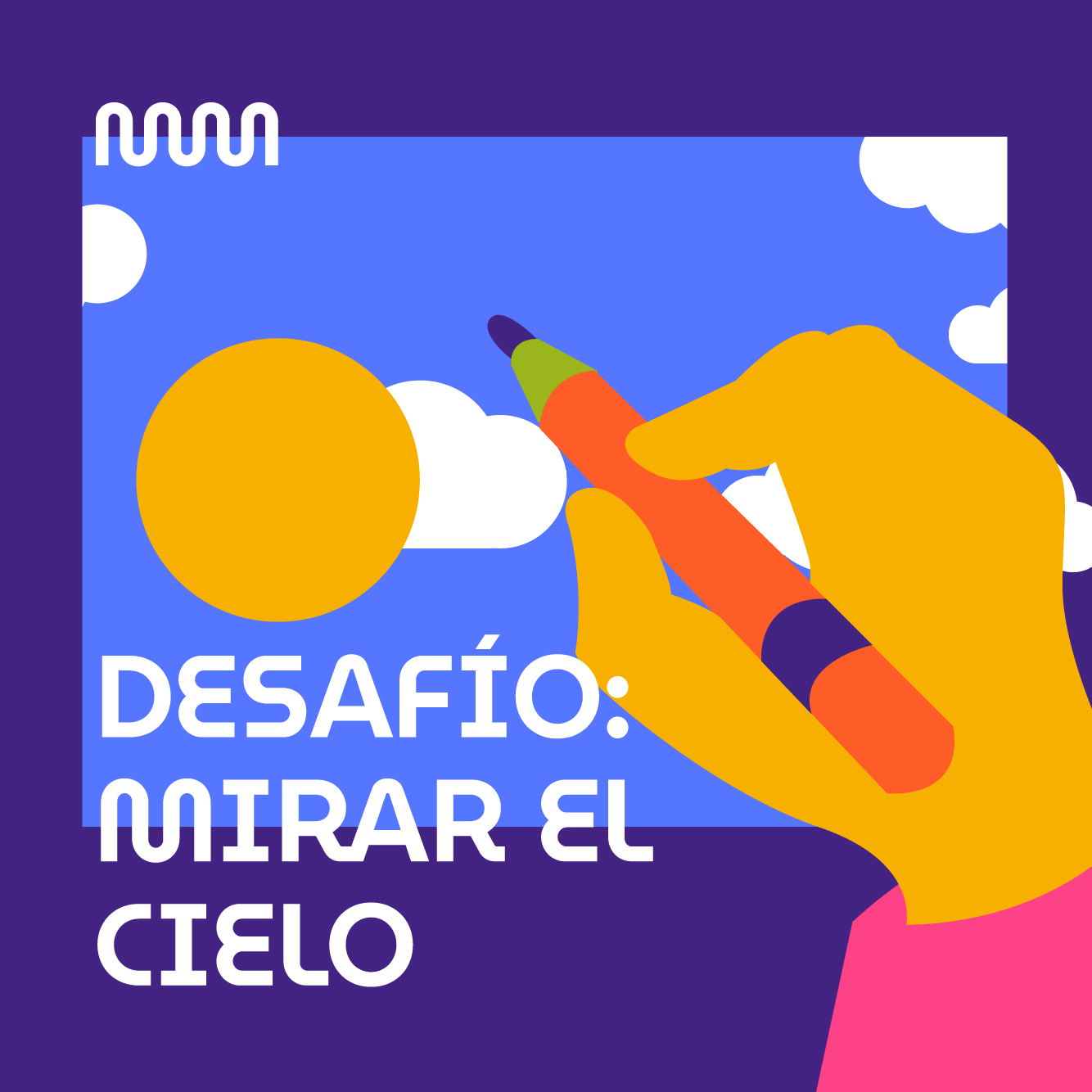
An activity designed to represent the sky from wherever you are.
Depicting landscapes is a vital part of an artist’s education. So we are inviting our little ones and their families to skywatch from their windows or balconies. The sky is a landscape that changes colour, texture and shape with weather, time and other factors. Draw, paint or depict the sky however you like, upload it to your social networks and tag the Moderno.
